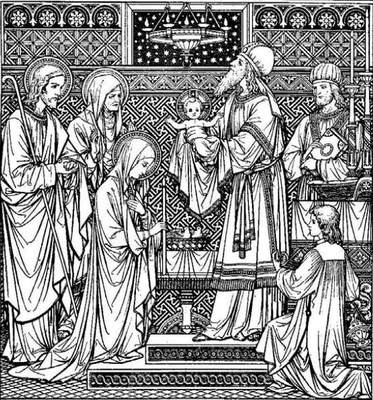 Luke 2:22-40 ‘A light to enlighten the pagans and the glory of your people Israel.’ (Luke 2:31-32) Last week during the notices I made a passing comment on how many traditions the Church treasured for centuries have been thrown away like the baby with the proverbial bath water. This streamlining of traditions can sometimes be a positive thing, but more often than not it has been prompted by a misguided belief that progress has made certain things redundant. Even the today’s feast has undergone drastic changes. Although it is still nicknamed Candlemas, many of the ceremonies have gone and this celebration has been completely rebranded to reflect a shift in people’s perceptions of childbearing, and to put more emphasis on the Lord Jesus, who – though an infant – is at the very centre of the gospel reading. Slightly older members of our congregation might remember Candlemas being called “The Purification of the Virgin Mary”, but today it is called “The Presentation of the Lord to the Temple”. Back then the Feast of the Purification went hand-in-hand with something called “the Churching of Women”, a service at which mothers were blessed after giving birth and formally readmitted into the liturgical life of the Church. But now, the Churching of Women has been largely discontinued by most Christian denominations, and so has the ancient name of this Feast. Back then the Feast of the Purification was a special festival in honour of our Lady; but now our attention is drawn especially towards her Son who enters in his own Temple at Jerusalem as God-made-flesh for the first time. Reflecting the gospel reading, now our Lord is at the centre of Candlemas; and he is once more the reason for our celebration. The old focus of Candlemas was Mary and Joseph coming to the Temple to fulfil the requirements of the Jewish Law. Now the liturgy calls us to look upon the infant Jesus with the eyes of Anna and Simeon, and to see in him light and salvation. One ancient tradition, however, survives; the blessing of candles. About one thousand years ago Saint Anselm, Archbishop of Canterbury, preaching on this feast said of these candles, ‘The wax which is the product of the virginal bee, is the Flesh of our Lord; the wick, which is within, is His Soul; the flame, which burns on top, is His divine nature.’ And a few moments ago, we were holding the same lit candles, the same symbol of Christ, like the people in Anselm’s congregation did, and like countless generations of Christians before them. One of the reasons for the enduring popularity of this tradition is found in our gospel reading where Simeon describes Jesus as ‘a light to enlighten the pagans’ meaning that, through Jesus, God is revealed to all, not just God’s ancient people. Through him – our Emmanuel, God-with-us – no-one is barred, and in him everyone is given access to God. Then, Simeon also says that the Jesus has come ‘so that the secret thoughts of many may be laid bare’; meaning that, in his brightness, the Lord is able to bring to light our innermost thoughts, even those things we hide from ourselves. So our candles are visible tokens of the spiritual enlightenment Jesus brings. They remind us that for us nothing should be more vital than the light of Christ; that we must learn to rely on his light while we journey on, rather than our sense of direction; and that we should follow the road that Christ illuminates for us until we reach our home. Traditions may come and go. A few may be discontinued for good reasons; others may just fall out of fashion only to be revived later on. But what remains of Candlemas has survived unchanged because it is a practical representation of Christ – the light at the centre of our celebration and, more importantly, the light that must shine at the centre of our hearts. Lead, Kindly Light, amidst th'encircling gloom, Lead Thou me on! Lead, Saviour, lead me home in childlike faith, Home to my God. To rest forever after earthly strife In the calm light of everlasting life.
0 Comments
Your comment will be posted after it is approved.
Leave a Reply. |
Archives
June 2020
Categories
All
|
 RSS Feed
RSS Feed


